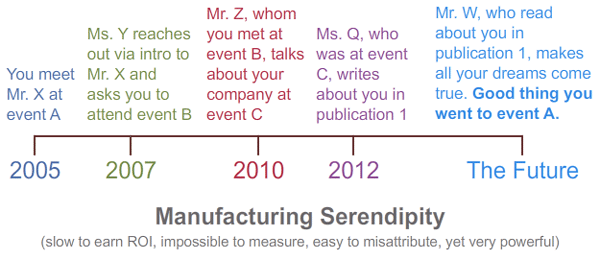I’m on the road ~100 days each year. When I’m in Seattle, I have at least 30% of my days filled with coffees, calls, and communication to folks outside the company from whom I’m seeking absolutely nothing and where my goal is merely to be helpful. I do most of this in the name of a process I now call manufacturing serendipity (though I didn’t actually think of it as an intentional thing until a couple years ago – the phrase was coined and told to me by my friend Dan Shapiro; Andrew wrote a bit about it on his blog).
_
This manufacturing serendipity business breaks down pretty much like this:
- Go to places that are not your office (conferences, events, meetups, trains, etc)
- Participate in things, learn things, and be generally game for new experiences
- Meet interesting people in the process
- Build relationships
- Be generally awesome by helping the people you’ve met and doing good deeds with no expectation of a return
- Repeat 1-5 hundreds of times
Reason #1: The true value of serendipity usually comes years down the line. Yet, human beings are hardwired to desire immediate returns. For example, in 2004, I formed an online friendship with a black hat SEO going by the online moniker of Earl Gray. Earl began corresponding with then-Newsweek-reporter Brad Stone. When Brad asked for a white hat SEO to help balance his article, Earl referred him to me, and SEOmoz earned the focus of the piece. Through a series of events (an invitation to a VC conference in Half Moon Bay, more press, more intros, etc) this led to my meeting Michelle Goldberg of Ignition Partners who funded Moz’s Series A round.
There’s no “long story short” with manufacturing serendipity. It’s a process that takes months or years to pay off.
Reason #2: It’s nearly impossible to measure the impact of serendipity. Tomorrow afternoon, I’m keynoting Hubspot’s Inbound 2012 conference to an audience of 2,500+ marketers. While the web marketer in me desperately wants to try some sort of mass chip implantation to track any potential activity resulting from the event, the realist knows it’s impossible (and thinks implanting chips in conference-goers is going way too far, unless maybe you’re Google). And yet, in the next 3-5 years, Moz will almost certainly benefit in some way, direct or indirect, from that presentation, and they’ll be no way to tie it back to this conference vs. the thousands of other interactions our brand has with marketers each month.
Living with the frustration of that un-trackability is hard, but essential. The truth is, that lack of direct attribution is one of the reasons it’s so powerful. If we could directly trace revenue or business impact, the magic of serendipity would be lost, and there’d be millions more people attempting to manufacture serendipity of their own, saturating the field and ruining any hint of authenticity in the process.
Reason #3: Attribution is almost always misplaced. All of us (but no one more than CEOs) want to believe that it is through deliberate, concerted, designed action that positive results for our companies are created (weirdly, negative results are often attributed to chance, but nevermind this irrationality of the human ego). Sadly, as any impartial observer knows, they’re not.
Positive results are a combination of skill, smarts, timing, people, and, yes, luck. Manufacturing serendipity is the process of increasing your odds through community interaction and good deeds. The trick is to remind yourself that when you scratch off a lucky winner, you don’t deserve it, but you may inadvertently earned it through some prior combination of wholly untraceable acts. Thus, the logical thing to do is not rest on your laurels, but get back out there and go manufacture some more.
——–
I don’t know what percent of CEOs consider this to be active parts of their job, but ever since my chat with Dan on the subject, I’ve had it hardwired that manufacturing serendipity, hand-in-hand with brand evangelism, should be at least 30% of my job. It’s something I’d recommend to others in my role, and to individuals of any profession who are seeking to advance their own careers and/or help the organizations they work for to achieve greater luck.

